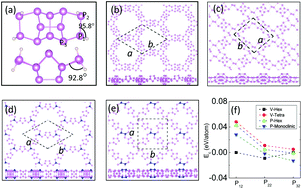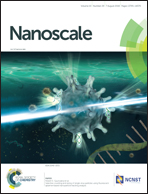Red phosphorus in its two-dimensional limit: novel clathrates with varying band gaps and superior chemical stabilities†
Abstract
First-principles calculations within density functional theory reveal the preferred structures of red phosphorus in the two-dimensional (2D) limit to be porous with intriguing structural, electronic, and chemical properties. These few-atomic-layer structures are stabilized as novel 2D clathrates with tunable pore sizes and varying semiconducting band gaps, labelled as V-Hex, P-Monoclinic, P-Hex, and V-Tetr in descending energetic stabilities. The cohesive energies of the 2D clathrates are all substantially higher than that of white phosphorus. More strikingly, the V-Hex structure is energetically as stable as black phosphorene, but possesses distinctly superior chemical stability when exposed to O2 due to the presence of a much higher activation barrier against chemisorption. We also exploit the salient properties of these 2D clathrates for their important application potentials, including serving as effective elemental photocatalysts for visible-light-driven water splitting, and as a new class of sieves for molecular separation and DNA sequencing.

- This article is part of the themed collection: 2018 Nanoscale HOT Article Collection


 Please wait while we load your content...
Please wait while we load your content...
